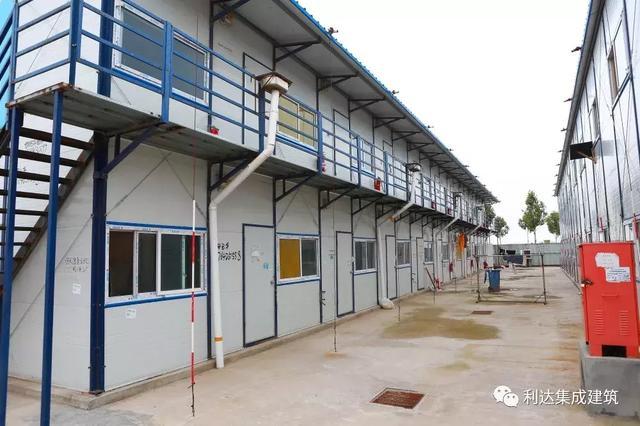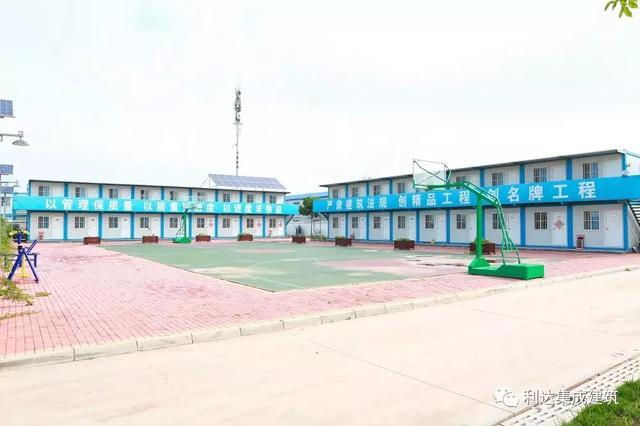Tel: 0086-532-88966982
0086-532-88965892
Website: www.lidajituan.com
E-mail: sales@lidajituan.com
Head office: 5th Floor, Building A, Darron Center, 180 Haier Road, Qingdao, 266000, China
Prefab House Durability: Mining & Energy Sector Applications by Lida Group
Classification:Industry News
Release time:2025-07-21 10:00
Prefab House Durability: Mining & Energy Sector Applications by Lida Group
Beneath the howling winds of an Arctic oil field, where temperatures plunge to -45°C, a prefabricated house withstands elements that cripple conventional structures. Its walls – engineered like pressure vessels – flex under hurricane-force blasts while maintaining thermal integrity. This isn’t theoretical resilience; it’s daily reality for energy crews operating Lida Group’s modular house solutions in environments where building failure isn’t an option. The mining and energy sectors’ brutal demands have forged a new breed of off-site construction – structures that don’t just endure, but conquer extreme industrial challenges.
The Industrial Endurance Imperative
Consider the harsh calculus of remote operations:
- A Siberian mining camp loses $2.8 million daily during blizzard shutdowns
- Offshore platform control rooms require uninterrupted operation during Category 5 hurricanes
- Acid mine drainage eats conventional buildings in under 5 years
- Seismic events interrupt mineral processing for weeks
These aren't hypothetical scenarios but daily operational realities. Prefab houses evolve from basic shelters into engineered survival systems where durability directly impacts profitability and safety.
Anatomy of Industrial-Grade Durability
Structural Resilience Framework
Beyond building codes – engineered for industrial assaults:
Material Science Innovations
Engineered substance over standard specs:
- Corrosion Combat: Nano-ceramic coatings bonded at molecular level
- Fire Armor: Intumescent paint expanding 30x at 200°C
- Thermal Defense: Vacuum-insulated panels maintaining R-60 values
- Impact Resistance: Laminated composites absorbing kinetic energy
Case in Extreme Execution: Copper mine camp in Chile’s Atacama Desert withstands daily thermal swings from 0°C to 45°C without structural fatigue.

Mining Sector Battlefields
Dust Warfare Environments
Gold processing sites where airborne particulates penetrate conventional structures:
- Defense Systems:
- Pressurized airlocks at all entries
- Electrostatic dust precipitation systems
- Hermetically sealed electrical conduits
- Durability Outcome: 92% reduction in equipment contamination
Seismic Hazard Zones
Mine offices atop active fault lines:
- Engineering Response:
- Friction pendulum base isolators
- Buckling-restrained braced frames
- Flexible utility conduits with slip joints
- Operational Proof: Operational during 7.8 magnitude quake
Chemical Exposure Frontiers
Metallurgical labs handling acidic slurries:
- Surface Protection:
- 3mm PVC membrane encapsulation
- Fiber-reinforced polymer wall panels
- Chemical-resistant epoxy flooring
- Longevity Data: 15+ year service in pH<3 environments
Energy Sector Endurance Engineering
Arctic Operations Standard
Drilling camps facing -50°C wind chill:
- Thermal Continuity Systems:
- Triple-sealed thermal break gaskets
- Heated threshold membranes
- Low-e suspended film glazing
- Performance Benchmark: Maintains +23°C interior at -52°C exterior
Offshore Survival Systems
Platform control modules in hurricane zones:
- Structural Integrity:
- Monolithic steel moment frames
- Hurricane-rated tie-down systems
- Watertight electrical penetrations
- Validation: Withstood 235 km/h winds during Hurricane Laura
Hazardous Area Compliance
Gas processing plant offices:
- Explosive Atmosphere Protections:
- ATEX-certified ventilation systems
- Intrinsically safe electrical fittings
- Static-dissipative flooring
- Safety Record: Zero ignition incidents over 12 years
Engineering Lifecycle Advantage
Accelerated Deployment Protocol
Permafrost terrain mine camp case study:
- Challenge: Establish camp before winter freeze
- Solution:
- Helicopter-transportable modules
- Screw pile foundations eliminating concrete cure
- Plug-and-play utility interconnects
- Timeline: 120-bed camp operational in 17 days
Maintenance Revolution
Remote wind farm maintenance hubs:
- Access Engineering:
- Removable exterior panel systems
- Color-coded utility routing
- Tool-less interior reconfiguration
- Impact: 70% reduction in service downtime
Adaptive Longevity
Copper mine headquarters evolution:
- Original: Worker accommodation camp
- Phase 2: Expanded to laboratory annex
- Phase 3: Converted to training center
- Structural Leverage: Bolt-together assemblies allowing reconfiguration

Durability Validation Metrics
Extreme Environment Testing Regimens
Beyond certification – real-world validation:
- Thermal Cycling: 500+ cycles (-50°C to +65°C)
- Salt Spray Endurance: 6,000+ hours ASTM B117
- Seismic Simulation: Successful 1.5g shake table tests
- Wind Tunnel Verification: Passed 265 km/h structural integrity
Field Performance Tracking
10-year audit of oil sands accommodations:
- Corrosion Resistance: 0.03mm/year material loss (industry average: 0.25mm)
- Insulation Stability: <3% R-value degradation
- Structural Deflection: Within 0.02% of original specs
- Maintenance Cost: 31% lower than site-built equivalents
The Circular Durability Advantage
Material Reincarnation Protocol
Decommissioned mine camp renewal:
- Stage 1: Office prefab house modules disassembled
- Stage 2: Structural members repurposed for seismic monitoring station
- Stage 3: Wall panels transformed into equipment shelters
- Result: 83% material utilization across three project lifetimes
Endurance Through Technology
Smart resilience systems:
- Corrosion Monitoring: Electrochemical sensors predicting coating failure
- Structural Health Tracking: Micro-strain gauges mapping load patterns
- Environmental Sensors: Real-time dust/chemical exposure mapping
- Impact: 97% prevention of catastrophic failures
Future Frontier Materials
Self-Regenerative Surfaces
- Microcapsule-based scratch healing compounds
- UV-triggered molecular realignment polymers
- Electroactive corrosion-inhibiting coatings
Phase-Change Structural Systems
- Paraffin-impregnated walls stabilizing temperatures
- Shape-memory alloys reverting after seismic deformation
- Thermochromic windows autonomously adjusting solar gain
Composites Evolution
- Basalt-fiber reinforced concrete
- Graphene-enhanced conductive surfaces
- Bio-based resins from industrial waste streams
Conclusion: The Unyielding Infrastructure Standard
When a nickel mine’s control center rode out an 8.3 magnitude earthquake without disrupting operations, it validated more than seismic engineering – it proved prefab building solutions could exceed site-built performance under catastrophic stress. Lida Group’s structures don’t merely outlast conventional alternatives; they redefine durability parameters for extreme industries.
The breakthrough lies in transcending shelter to create active survival systems. At their core, these are prefab houses engineered as environmental fortresses: where thermal breaks become energy conservation weapons, where corrosion coatings transform into molecular shields, where flexible connections act as seismic shock absorbers. Each mining camp and energy installation becomes a laboratory proving that when construction methodology evolves to match industrial challenges, durability becomes predictable rather than aspirational.
For mining firms facing billion-dollar weather delays and energy companies battling corrosive ocean environments, these structures represent more than operational facilities – they’re competitive advantages materialized in steel and advanced composites. The new frontier of industrial constructions isn’t built; it’s engineered for battle, factory-forged for endurance, and field-proven where failure carries unacceptable costs. This is durability beyond certification paperwork – it’s resilience written in operating records where storms, quakes, and chemical assaults become mere footnotes in decades of continuous operation.
prefabricated house,prefab building,modular house,constructions
Contact Us
Head Office: 5th Floor,Building A,Darron Center,No.180,Haier Road,Qingdao, 266000,China
Tel: 0086-532-88966982 88965892 Fax:0086-532-88965571
WhatsApp:+86 13793209022
Mobile/Wechat:+86-15166671720
Email: sales@lidajituan.com Website: www.lidajituan.com
Alternate Website: www.lidamodularhouse.com
Head Office: 5th Floor,Building A,Darron Center,No.180,Haier
Road,Qingdao, 266000,China
Tel: 0086-532-88966982 88965892
Fax:0086-532-88965571
Email: sales@lidajituan.com
Website: www.lidajituan.com
Alternate Websit: www.prefabhousecn.com
Wechat/WhatsApp:+86-13793209022
Copyright(c)2023 All Rights Reserved SEO Business license

